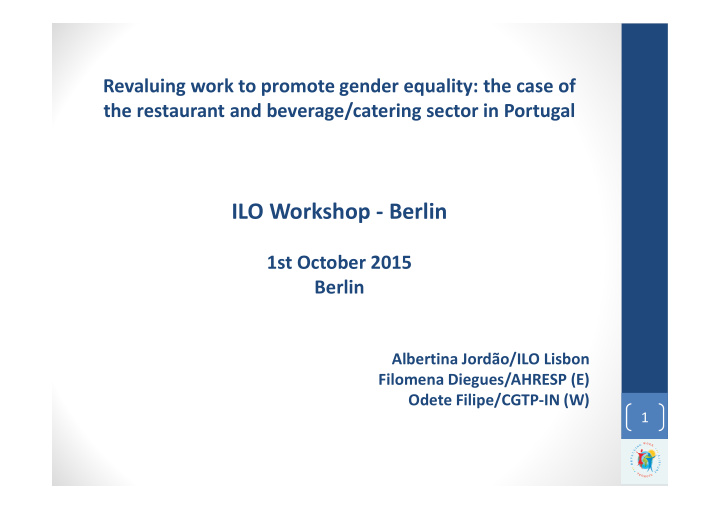



Revaluing work to promote gender equality: the case of the restaurant and beverage/catering sector in Portugal ILO Workshop - Berlin 1st October 2015 Berlin Albertina Jordão/ILO Lisbon Filomena Diegues/AHRESP (E) Odete Filipe/CGTP-IN (W) 1
Presentation plan • Introduction and context • Strategies adopted and why this project is important for the ILO • Main challenges (the sector) • Outcomes and lessons learned 2
I - Introduction and context � Tripartite work/tripartism as a governance model (ILO) � ILO C. 100 and R. 90 (1951) Why definitions matter? We need to have a shared and common understanding: Work of equal value; Remuneration… Article 1 For the purpose of this Convention-- (a) the term remuneration includes the ordinary, basic or minimum wage or salary and any additional emoluments whatsoever payable directly or indirectly, whether in cash or in kind, by the employer to the worker and arising out of the worker's employment; 3 (b) the term equal remuneration for men and women workers for work of equal value refers to rates of remuneration established without discrimination based on sex.
I - Introduction and context � Strong and committed partnership � Different starting points and different needs/views (Employers/Workers) Employers Workers Sector needs to be more Discrimination in wages competitive More qualified staff whose Female dominated jobs talents are recognized poorly remunerated High turnover Importance within tourism Poor working conditions 4 industry
II - Strategies adopted and why this project is important for ILO � Tripartite partnership and all the process (open debate with all the actors) � Training/solid knowledge of the Job Evaluation Method (JEM) � Equal remuneration is one of the fundamental rights at work (1998) � The tripartite social dialogue on equal remuneration: Legitimacy and quality of the work done 5
Motivations for the project • In most of situations, women are in the lowest levels, classes or degrees of a professional category, although they perform the same tasks or tasks of equal value 6
Effects of the pay gap • Women are hardest hit: - On sick leave; - In the unemployment benefits; - In the licenses, absences and maternity leave • Women pensions are 60% of men's (with the same contributory scheme) 7
Detected problems • Practical difficulties of transferring legal concepts of indirect discrimination, for concepts of measuring in order to be more easily used in collective bargaining 8
Tripartite social dialogue Partnership • Workers Representatives • Employers Representatives • Government Organizations Representatives • Research organizations 9
Critical points • Lack of experience in this area • Constitution of team with adequate profile • Training of participants • The selection of the method and ownership by the partners • Knowledge about the sector • Establishment of a consensus between the parties 10
Outcomes • Setting up a Job Evaluation Method Free from Gender Bias, focus on the job’s content (whether performed by men or women). 11
Outcomes • Establishment of a Common frame of Reference on Equal Pay and on the Job Evaluation Method which is included in the National Catalogue of Professions, providing a 25 hours training module to be integrated in all public/private vocational training courses 12
Strongpoints • The method is systematic and include tools to collect information and to conduct a direct observation usually used in inquiries of scientific basis • Makes visible the work performed by women, allowing it to be compared and evaluated • Gives dignity to all professions 13
Strong points • While referential for rethink the content of jobs is a tool to support collective bargaining • Transferable process, if properly adapted to other Business Sectors 14
Thankyou! Odete Filipe mariaodetefilipe@gmail.com www.cgtp.pt 15
The problem Identify wage discrimination based on gender *** 16 The goal Create and test a job evaluation method free from gender bias, applicable to economic activities
Why the food & beverage sector? � One of the biggest national employers year 2008 79.388 companies 232.333 workers 17 � 10% of GDP (Gross Domestic Product) � Most relevant activity of the Tourism industry
Other specific characteristics: � Mostly women in low payment occupations; � High staff turnover; 18 � Low qualifications; � Low dignification in some occupations; � Mainly micro and small enterprises.
Why AHRESP? � The most representative employers' association in the food & beverage sector; � Profound knowledge of the food and beverage 19 activity and its weaknesses; � Good relations with trade unions and government structures; � Collective bargaining / collective labor contract.
Working g progress � Development of a specific questionnaire; � Questionnaire reply by employees - both man and women; 20 � The results were analyzed and evaluated.
Key issues to success � Participation of the various players: employers' associations, trade unions and public authorities the importance of the social dialogue; 21 � Deep knowledge about the concepts and their correct identification; � Good knowledge of the economic activity under study;
Key issues to success (cont.) � knowledge about national law regarding gender equality; 22 � Provide adequate training to those who will perform the work.
Additional gains (sector): � Identification of cases of nonconformity; 23 � Allowed us to detect situations in other areas in need of correction; � Provided important information for future collective bargaining.
Economi mic data 24
25 Thank you very much for your attention! Filomena Diegues filomen ena.diegues es@ahres esp.co com www.ah ahres esp.co com Berlin, 1 st October er 2015
Recommend
More recommend